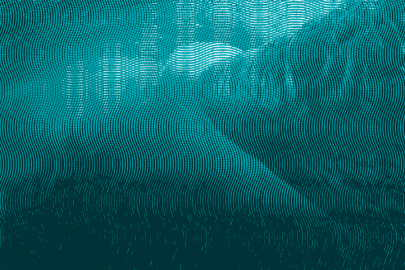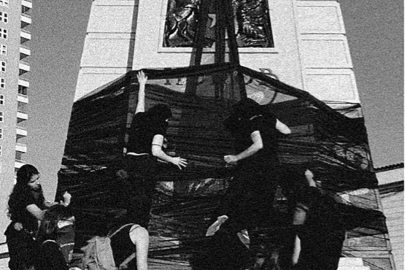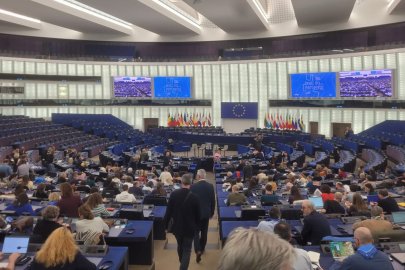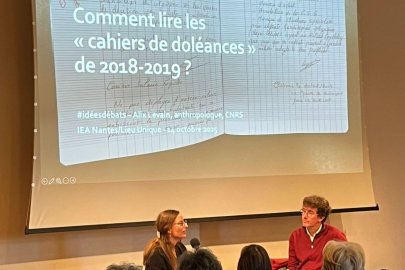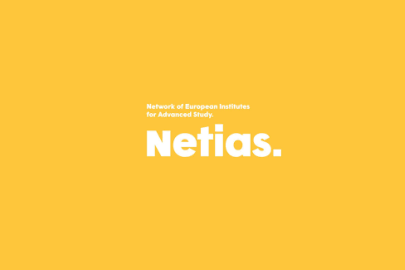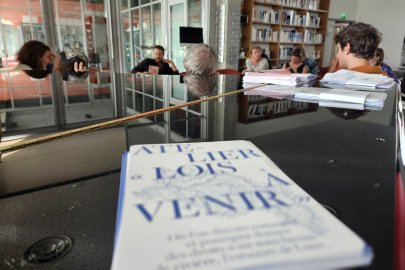In a context of ecological urgency, Sophie Halart proposes to revisit art history through an oceanic perspective, inspired by the Humanities. She challenges the terrestrial and colonial orientation of the discipline, historically founded on taxonomy, formal stability, and visibility—as defined by Winckelmann, Riegl, or Focillon—and advances the idea that, although certain formalisms have employed maritime metaphors, these founding principles have largely remained anchored in a logic of external observation, perpetuating an episteme inherited from Enlightenment philosophy.
Halart calls for a conceptual shift: to think art history not from solid foundations, but from the turbulence, instability, and fluidity inherent to the oceanic milieu. Drawing on work from environmental and decolonial humanities, she questions dominant disciplinary metaphors (field, progress, clarity) and advocates for a dive into submerged narratives, often subaltern or silenced. She evokes the traumas linked to transatlantic globalization (slavery, colonization, ecocide) and the possibility of an epistemology of relation, founded on interdependence rather than hierarchy.
This blue rereading finds resonance in the work of Aby Warburg, whose notion of Nachleben proposes a liquid and spectral temporality of forms. Halart thus calls for disciplinary disobedience: to abandon linear cartography in favor of practices of montage, listening, and resonance. Rethinking art history in a “blue tone” is to make the sea not merely an object, but a matrix for thought and repair.
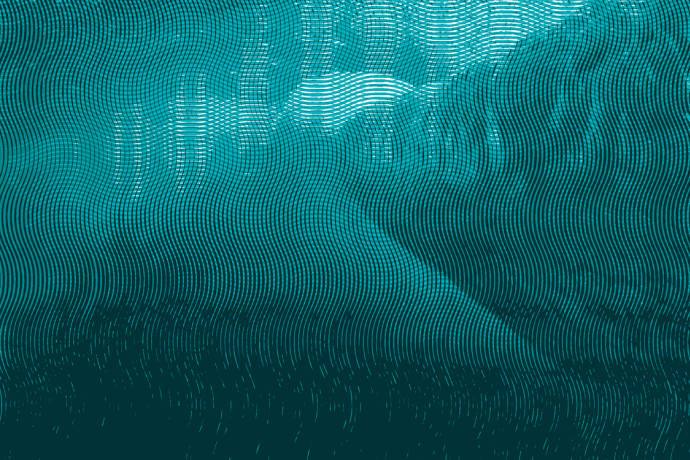
Introduction
In the current context of growing anxieties about the planetary future and the spectacular nature of the Anthropocene, Art History faces the need to revise its visual regimes of reference and the ontological assumptions that support them (Patrizio 2019). Although the discipline has consolidated critical tools to reflect on the relationship between the image and some of the myths of Modernity (progress, positivism, artistic genius), it still harbors deep traces of colonial and naturalist orderings in its epistemological structure (Flores et al., 2024; Zhong Mengual, 2021). Moreover, the discipline suffers from an excessively telluric orientation in its conception of knowledge.
This orientation has shaped how image, space, form, and time are conceived within the field. Throughout the 19th and 20th centuries, art theorists and historians operated with tools that—even in their most formalist versions—reproduced classificatory and periodizing logics rooted in Enlightenment modernity. The visual regime upon which much of the discipline is founded rests on a terrestrial ontology that turns the world into an object of analysis, conquest, or archive. This logic is not neutral: it has organized and systematized ways of seeing and representing that consolidate epistemic regimes centered on the solid, the stable, and the measurable.
Against this paradigm, Environmental Humanities—and more recently, Blue Humanities—open a critical path to de-center the historiographic canon from speculative perspectives that can destabilize the discipline’s terrestrial bias and invite it to adopt an oceanic gaze, privileging flow, immersion, and the murkiness of backwash. Applied to a critical rereading of the canonical art historiography, this “blue turn” challenges the linearity of the disciplinary narrative and questions notions of authorship, permanence, visual centrality, and epistemological territoriality, whose contours dissolve in their encounter with what Margaret Cohen and Killian Quigley call “the underwater awkwardness of the sublime” (Cohen & Quigley, 2018, p. 15). Just as Vilém Flusser (1987) rethought writing from the subaquatic abysses of the vampire squid or Melody Jue (2020) articulated amphibian forms, we might ask: What regimes of power and alternative narratives can emerge from Art History’s contact with other densities, temperatures, and salinities? What submerged structures, spectral regimes, and sunken bodies might surface in this disciplinary dive?
1. The Origins of the Discipline: Telluric Foundations and “Onboard” Perspectives
Art History, as it became institutionalized from the eighteenth century onward, was based on an Enlightenment logic that privileged taxonomy, visibility, and formal stability. While Giorgio Vasari occupies a foundational place in the disciplinary genealogy, it was Johann Joachim Winckelmann who, from an archaeological perspective, laid the modern foundations of the discipline as a scientific form of knowledge.
Winckelmann inherited from Enlightenment thought a telluric construction of knowledge: knowledge as a rational construction against the chaos of the unknown. Jean d’Alembert, in his celebrated Discours préliminaire (1751) for the Encyclopédie project, compared the construction of knowledge to the formation of continents emerging from the ocean, conceived as a vast expanse yet to be discovered. “The universe is nothing but an immense ocean, on whose surface we perceive islands of varying size, whose connection to the continent remains hidden” (cited in Roman, 2023, p. 45). This image, revisited by Hanna Roman (2023), illustrates an insular epistemology, opposing the territoriality of the known to the liquid mass of uncertainty. Within this logic, scientific vision aims to make the submerged or unknown emerge in solid and recognizable form. Thus, the discipline is born under a telluric conception of knowledge, converting art—and with it, its history—into a series of sediments subject to classification, ordering, and systematization. The ocean, in this context, represents the antithesis of this epistemic horizon: a threatening and elusive figure, an informal and formless expanse in its otherness, opposed to the consoling clarity of land.
The study of the periodic resurgence of motifs from earlier times was analyzed by Winckelmann as a somewhat nostalgic quest to regain the formal perfection of ancient art. Nineteenth-century art historians took up this question and developed a methodology for analyzing the recurrence of forms, based on a formalist thought whose horizon was the emancipation of form from exclusively period-based interpretive frameworks. Alois Riegl, founder of the Vienna School, introduced the concept of Kunstwollen or “artistic will” to describe a formal impulse inherent to each epoch, shaped by an unconscious collective historical will (Iversen, 2003). According to Riegl, styles respond to an internal energy manifested through formal configurations, whose purest expression is found in abstract language.
Formalism thus introduces an interesting shift in the discipline: a sensitivity toward a more fluid reading of art, in which forms cease to be seen as solid blocks and begin to be understood as currents that evolve, mutate, and transform. Henri Focillon, another prominent formalist, even refers in La vie des formes (2010) to forms as expressions of the “oceanic depths of life,” as “limitless waves” that rejuvenate the spirit through art (pp. 80–83).
By framing formal evolution as a phenomenon of flow, formalist thinkers seem to suggest the organic genesis of certain motifs and allude to their matrix in oceanic terms. Applying a “blue” lens to these texts, one can identify a dynamic of backwash that understands formal evolution as a phenomenon of waves, recurrence, and sedimentation. It is worth noting, however, that this language, while evoking maritime imagery, does not entirely abandon dry land. Formalism is more of a crossing than an immersion: it proposes an “onboard” gaze that remains at the surface, seeking to read in the breaking lines of the waves the expression of unconscious subaquatic phenomena.
In this sense, formalism does not entirely free itself from the logic of observation inherent to Enlightenment knowledge: the art historian, like the modern scientist, remains external to the phenomenon under study. The ocean here functions as metaphor, not as epistemic environment. Fluidity is thematized, but not experienced. Therefore, formalism, however dynamic it may seem, still operates within a telluric episteme: it replaces the archaeological metaphor with an oceanographic one, incorporating the lexicon of waves and currents without relinquishing the centrality of the gaze.
2. Coloring Art History Blue: Conceptual Shifts
The turn initiated by the Environmental Humanities—and more specifically by the Blue Humanities—in their critical rereading of the ideologies underpinning our current paradigms, opens the door to a deconstruction of the telluric and/or onboard foundations of earlier historiographic proposals. It confronts the discipline with an immersion that is more porous, but also more perilous. In her book Wild Blue Media, Melody Jue invites us to a conceptual shift—in oceanic key—capable of unsettling our terrestrial biases. How might this challenge be addressed in art history? What would it mean for the ways we read and write about art? This task remains to be undertaken and still holds an openly speculative character.
This proposed oceanic turn in art historiography is not limited to a conceptual or methodological wager. It is, above all, an invitation to destabilize the regimes of knowledge built on the epistemological solidity of land. By embracing the instability, circulation, and turbulence inherent to the aquatic environment, this turn proposes a radical de-centering of the modern foundations that shape our ways of thinking and representing the world, as well as the colonial and extractivist assumptions those foundations carry.
In his book Ocean (2020), Steve Mentz suggests we experiment with inverting our entrenched academic metaphors. What would happen, he asks, if everything solid became liquid? What if, instead of thinking of our disciplines as fields of expertise, we conceived of them as currents? What would it mean if the idea of exponential progress, characteristic of our modern imaginary, adopted the circularity of flow? From these questions, Mentz proposes replacing certain established terms with others of maritime origin: “field” becomes “current,” “ground” becomes “water,” “progress” becomes “flow,” “State” becomes “ship,” and “clarity” becomes “distortion.” “Our metaphors,” he writes, “should float in water rather than take root in the land” (p. 45).
This exercise in lexical substitution reveals not only the ideological implications of our metaphors but also the visual distortion inherent to the aquatic medium, which challenges the canons of clarity and transparency associated with modernity. Stacey Alaimo (2025) and Melody Jue (2020) have explored how immersion in liquid radically alters perception: the body becomes denser, slower; vision, more unstable; orientation, more uncertain. The amphibious research they propose introduces not only sensory variability but also epistemological shifts. To de-center the gaze is to de-center the authority of knowledge.
Likewise, engaging with the ocean from a decolonial perspective opens a vertical axis of displacement and trauma that injects moral murkiness into the linear logic of the European voyage. Steve Mentz (2020) speaks of a “wet globalization,” whose founding currents—conquest, the triangular trade, transatlantic slavery—continue to resonate traumatically in the present. Paul Gilroy’s “Black Atlantic” (2014), Raúl Zurita’s “sea of stones” (2018), or Kathryn Yusoff’s “oceanic cemetery” (2018) are other figures that encapsulate the foundational violence embedded in modern maritime imaginaries.
Artist Enrique Ramírez has explored this spectral dimension of the sea as a sonic archive of disappeared bodies, interweaving colonial, dictatorial, and ecological violence. Scholar Macarena Gómez-Barris (2017), in turn, proposes adopting a “submerged perspective” to attend to those infra-narratives that resist institutional visibility. This de-hegemonizing perspective replaces the logic of the voyage with that of the plunge. It transforms expansion into a force that refuses to fit within terrestrial, telluric, or continental categories of knowledge; it constantly exceeds them and returns to their shores the memories and materialities of subjugated lives.
In this sense, the notion of “relation” proposed by the Antillean thinker Édouard Glissant proves fundamental (2017). A voyage implies a point of departure and one of arrival. A plunge into the oceanic whole, by contrast, identifies dynamics of shared belonging and interdependence: a space of “Relation,” in Glissant’s words, that rejects the separatist hierarchies of colonial knowledge and proposes instead a radical “infinitude,” as well as the idea of a science—or a work—forever in process. The sea ceases to be merely a stage for transit to become an epistemic matrix: a space of co-belonging, mixture, and resonance.
3. Submerged Echoes: Warburg and the Oceanic Life of Forms
The epistemological decentering promoted by the Blue Humanities may appear relatively recent, inspired by necessary exercises in reflection and repair concerning colonial traumas. However, it does not represent an absolute rupture or radical innovation compared to certain earlier intuitions. To think of disciplines in terms of flows and currents is, in itself, contrary to any reading based on abrupt rupture. It is worth remembering, too, that the logic of the plunge and immersion introduced by the blue turn in art historiography resonates with ideas previously formulated by voices considered, at various times, heterodox within the disciplinary field.
If the thinkers of formalism clung tightly to the railing of their metaphorical vessel, one of their heirs jumped into the water: Aby Warburg. His thinking anticipates an art history open to latency, repetition, and the afterlife of forms—a history open to fluid and spectral forms of knowledge.
The concept of Nachleben—the survival or afterlife of images—introduces a wandering temporality, in which signs of the past resurface charged with affective energy, destabilizing conventional chronological frameworks. For Georges Didi-Huberman (2003), a great reader of Warburg, this insistence on latency opens art history to a liquid and protean dimension: “Nachleben is impure in the same way that Leben itself is: both are disordered, protean, liquid, oceanic in their scope and complexity, impermeable to analytical organization” (p. 282).
In opposition to the cartographic rationalism of Renaissance perspective—and to the methodological linearity that dominated much of the nineteenth century—Warburg sketched the contours of an amphibian gaze, capable of moving between disciplines, between times, and between images without being fixed within a logic of progress or closure. His Mnemosyne Atlas, an unfinished but emblematic project, constitutes a visual archive in which images are not arranged chronologically, but rather relate through affective intensities, recurring gestures, and internal movements. In this visual constellation, montage replaces linear narrative, and resonance displaces hierarchy.
From an oceanic viewpoint, Warburg’s work proves especially fertile. His sensitivity to the spectral, the formless, and the relational allows us to imagine a submerged historiography—open to undisciplined forms of knowledge. Despite his Eurocentric context, Warburg seems to intuit that images do not adhere exclusively to visible structures or fixed chronologies; instead, they emerge and reappear like underwater currents, laden with memory, pain, and persistence.
To think of an Art History in “blue tone” is, in this sense, to embrace that turbulence. Unlike the bird’s-eye view of the historian-cartographer, the approach proposed by Warburg—as with contemporary oceanic epistemologies—requires submerging oneself, accepting distortion, displacement, and the unexpected appearance of the repressed. His legacy, Eurocentric though it may be, can now be read as an invitation to reimagine the discipline’s methods not as instruments of order and organization, but as practices of listening and resonance. Also, as an invitation to disciplinary disobedience.
Unresolved Drifts
To adopt an oceanic gaze in Art History is not merely a terminological or aesthetic shift: it is, above all, a political and ethical gesture. This blue turn challenges our most deeply rooted disciplinary certainties and proposes a historiographic practice less centered on stability, visibility, or progress, and more open to instability, opacity, and the plunge. To return to the sea—not as a romantic or sublime symbol, but as an epistemic environment—implies abandoning the safety of maps, straight lines, and canonical chronologies. It means accepting the turbulence of forms, the density of submerged memories, the vibration of surviving images.
From this oceanic perspective, Art History can actively contribute to contemporary debates around environmental crisis, epistemic justice, and historical repair. By attending to sunken bodies, to invisibilized narratives, and to the floating forms that confront us from the depths, the discipline can reinvent itself as a submerged practice: a way of diving into what remains, as yet, unspoken.
References
Alaimo, S. (2025). The Abyss Stares Back: Encounters with Deep-Sea Life. University of Minnesota Press.
Cohen, M. & Quigley, K. (2019). The Aesthetics of the Undersea. Routledge.
Didi-Huberman, G. (2003). « Artistic Survival: Panofsky vs. Warburg and the Exorcism of Impure Time », Common Knowledge, 9(2), pp. 273–285. https://doi.org/10.1215/0961754X-9-2-273.
Focillon, H. (2010). La vie des formes. Mexico : Universidad Nacional Autónoma de México.
Flores, T., San Martin, F., & Villaseñor Black, C. (2024). The Routledge Companion to Decolonizing Art History. Routledge.
Flusser, V. (2011). Vampyroteuthis Infernalis. Atropos Press.
Gilroy, P. (2014). Atlantique noir : Modernité et double conscience. Madrid : Akal.
Glissant, É. (2017). Poétique de la relation. Éditions de l’Université Nationale de Quilmes.
Gómez-Barris, M. (2017). La zona extractiva : écologies écosociales et perspectives décoloniales. Santiago : Metales Pesados.
Iversen, M. (2003). Alois Riegl: Art History and Theory. Cambridge, MA : MIT Press.
Jue, M. (2020). Wild Blue Media: Thinking Through Seawater. Duke University Press.
Mentz, S. (2020). Ocean. Londres : Bloomsbury Academic.
Patrizio, A. (2019). The Ecological Eye: Assembling an Ecocritical Art History. Manchester University Press.
Roman, H. (2023). « Knowledges », in A Cultural History of the Sea in the Age of Enlightenment, pp. 27–42. Londres : Bloomsbury Academic.
Yusoff, K. (2018). A Billion Black Anthropocenes or None. University of Minnesota Press.
Zhong Mengual, E. (2021). Apprendre à voir. Le point de vue du vivant. Arles : Actes Sud.
Zúrita, R. (2018). Un mar de piedras. Santiago : FCE Chile.

